The Ellen Pettit Memorial Hall, Woburn Sands
Alfred Willian Pettit was born in 1856 in Sherington, Bucks. His parents were William, a farmer (and possibly a butcher) and Sarah. There were a number of Pettit families around the area of Sherington, Emberton, Olney and Newport Pagnell. I cannot locate him on either the 1861 or 1871 censuses.
Alfred’s obituary says he went to school in Eaton Socon before going to London to learn to be a draper; a far-cry from farming the North Bucks countryside. He obtained a position with Harvey & Nichols, of Knightsbridge, possibly as an apprentice. By the time of the 1881 census, he was living at no.210 Sloan Street, Chelsea, along with a large number of draper’s assistants.
In April 1887 he married one Ellen Franklin of Bedford. The marriage took pace at St. Saviours Church, Southwark. The notice in the Leighton Buzzard Observer describes her as Ellen (Nellie) Franklin.
Having found his calling and learnt his trade well, he left Harvey & Nichols to set up his own business on Kensington High Street, eventually spreading out to cover nos.191-195, which is now a Waterstone’s book shop. This had happened by November 1899, as he was advertising in the Daily Telegraph for a “Young Lady Wanted – at once, for Fancy department.” His obituary says he had bought the freehold of the site and erected new buildings. Alfred and Ellen were living at no.193 Kensington High Street at the time of the 1901 census, with Alfred described as a Draper and employer, with three servants. Ellen’s birthplace is listed as Paulerspury, Northants.
Business must have been good. By the age of fifty, they were able to retire to Aspley Heath, although the business in London kept running under his name. In October 1906, he is listed as living in Aspley Guise (as Aspley Heath was then considered) and gave a donation to the North Bucks Hailstorm Fund after a bad storm. In January 1907, there is a report that he had been involved in an accident in his trap at Broughton. Pulling over to let a car pass (driven by J. I. Boswell, J.P., of Crawley Grange), the trap containing Alfred, his brother and sister-in-law, was tipped into the ditch and the occupants thrown out, but they were only bruised and shaken.
They were living at a house called Croyland, an attractive mansion near the top of Church Road, Aspley Heath. It was then owned by the Duke of Bedford, so the Pettit’s were only renting. Even in retirement, Alfred’s business interests continued locally and expanded to estate, as he was the buyer of Wavendon’s Manor Farm when it was auctioned in May 1907. He paid £3,500.
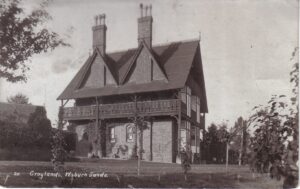
He became involved in many local social committees and boards and was on the Parish Council of Aspley Heath by 1910, becoming Vice-Chair by 1920. The 1911 census showed them still living at Croyland with one servant. He helped raise £20 for the Belgian Relief Fund at the start of the First World War by organising some concerts. He represented Aspley Heath on the Emergency Committee during the early 1920’s Great Strike period, ensuring food and fuel supplies were maintained. He was a Parish Warden at St. Michael’s, Aspley Heath, from 1916-1926 (except for a year 1922-23), where they both took an active part in church life. Alfred was also an enthusiastic member of the Woburn Sands Bowls Club. He is recalled in Evelyn Wright’s history of St. Michael’s as often riding his horse down from Croyland to Woburn Sands.
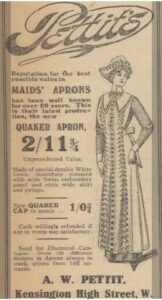
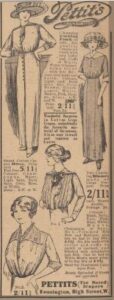
On 28th June 1927, Ellen Pettit passed away at home, aged 68. The Beds Times reported that it was due to pneumonia, after only a few days’ illness. She was described as “an indefatigable church worker, and took considerable interest in the missionary and other activities the local church”. The funeral was at St. Michael’s, with a large number of mourners from all sections of the local community attending. Her loss after 40+ years of marriage deeply affected Alfred and, as it had been her wish to see a church hall in Woburn Sands, he decided to go ahead and have one built in her memory.

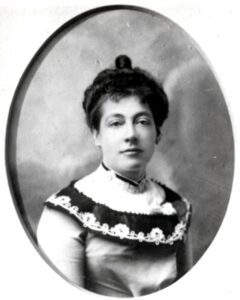
The idea had already been decided by January 1928, as it was reported in the Newcastle Journal (but not apparently, our own local papers?) At that time, the Vicarage in Woburn Sands was Shelton House (now Fenton House) in the High Street, which had land around it on three side. Some of this land was given for the new hall. More detailed information comes in the news report of the opening of the hall from the Bedfordshire Times of 10th August 1928:
“PARISH HALL FOR WOBURN SANDS. OPENING AND DEDICATION BY THE BISHOP
The memorial hall in the High Street, Woburn Sands, erected by Mr. Alfred William Pettit in memory of his wife, the late Mrs. Ellen Pettit, was opened and dedicated by the Bishop of St. Albans on 2nd August. Mrs. Pettit was a devoted worker at St. Michael’s Church, being connected with the Mothers’ Union and other parochial organizations, and one of her special activities was the decoration of the altar on festival occasions. During the twelve years or so that her husband was churchwarden she was an untiring helpmate to him, and it was the cause of much sorrow that she did not live to see the realization of one of her most cherished dreams – the provision of a parish hall. Since her death about a year ago Mr. Pettit has made himself responsible for the building of the fine hall that was opened this week and which will be known as “The Ellen Pettit Memorial Hall”.
THE HALL DESCRIBED
The Hall stands adjacent to the Vicarage, and is built upon a plot of land that was left for the purpose when the Vicarage was transferred from the Duke of Bedford to the Commissioners. The site was somewhat restricted in size, but the best possible use of it has been made, with the result that the Hall measures 55ft. long by 24ft. wide, and is capable of holding 250 people. It is recessed from the High Street path, and besides the front porch there are entrances from the Vicarage grounds and from the south side. There is a classic pedimented front, and on the stone facia are the words “The Ellen Pettit Memorial Hall” in coinage bronze lettering. The sides of the building are red brick piers with rough-cast panels, and there is an open panelled roof fitted with exhaust ventilators. Steel sash windows give an abundance of light, and the artificial illuminant is electricity. The general style of the hall is in harmony with the Vicarage, and its appearance both within and without are pleasing in the extreme.
There a lobby on the eastern entrance, and at the back of the raised stage are two artists’ rooms, with the necessary accommodation to each. At the rear there are offices for the Sunday School children, in addition to a barn and a boiler house with the necessary equipment for tea-making. It is intended to adapt the stage at a later date for the purpose of amateur theatricals. The contract price was about £1,625. The memorial tablet on the north interior wall is in dark stained oak, with a stone surround forming a Maltese cross. The inscription, which is in antique silver lettering, is as follows: “St. Michael’s Church Memorial Hall was erected in 1928 by Mr. A. W. Pettit to the Glory of God and in loving memory of his dear wife, Ellen Pettit, for many years a devoted church worker in this parish.”
THE OPENING CEREMONY
The Vicar (the Rev. J. Shelton) presided over the gathering that completely filled the hall, accompanied by the Bishop and Mr. Pettit. Others present were the Ven. A. H. Parnell, Archdeacon of Bedford, the Rev. R. C. F. Scott, Rural Dean of Fleete, the Rev. F. Hort (Aspley Heath), the Rev. A. Mattison (Aspley Guise), the Rev. J. F. Downes (Cranfield), the Rev. Canon Grey (Woburn Sands), the Rev. J. Rust (Husborne Crawley), the Rev. Mr. Drew (Aspley Guise), the Rev. W. S. Eaton (Woburn Sands), Mr. S. C. Denton and Mr. W. H. Bazley (churchwardens). Mr. Hebard (Secretary of the Parochial Church Council), Mr. W. B. Stonebridge (architect), Mr. H. K. Foster (representing Messrs. Samuel Foster Ltd. Kempston, the builders). Professor Barnes, Messrs. J. Barker, Markwell, Payne, Brewster and Charnock Smith, Mrs. Shelton, Mrs. Hamilton and Miss Mowbray.
The proceedings having been opened with the National Anthem, the Vicar spoke in high terms of Mrs. Pettit’s work for the parish, and explained that although Mr. Pettit had so generously built the Hall itself, £100 was still needed to pay for its furnishing. He appealed for donations towards reducing that debt.
The memorial tablet was then unveiled by the Bishop, and verse of the “Old Hundredth” was sung as he returned to the platform. After a prayer of thanksgiving and dedication the Bishop next dedicated the Hall in the following words “In the faith of Jesus Christ we dedicate this building to the greater Glory of God and in memory of his servant, Ellen Pettit.”
In his address the Bishop said that their first thought must be of thankfulness that God had put it into the heart of Mr. Pettit to commemorate his wife in this way. He did not suppose that there was any country in the world so full of outward and visible signs today of the benefactions of the past. The old village Parish Churches were in most cases the gift of one man or one family, and, although conditions had changed and times had become difficult, he did not believe that generosity of that kind was a thing of the past. The young people of today had more opportunities of amusement, of social life, and moving about from place to place than were enjoyed by those of former generations, and it was the Church’s duty see that they were properly guided in the use of these new opportunities. After the Parish Church the next important thing in any parish was a hall that could be the centre of the young people’s social life, for without it the family spirit that should be found in the parish was impossible. He was keen in seeing that the “betwixt and between” young people should receive a welcome from church people, and that they should be made to feel at home among them. It was a good thing for older people to remember that they were once passing through the difficult years when they thought they knew everything – the time when they too were quite intolerable to older people. Some of them got through it successfully with the help that was given to them at public schools, but let them not forget how much more difficult was that period of life for the young people of Woburn Sands and other places, who, although they might have received a perfectly good education, had not the advantages of passing through the adolescent stage in the social life of a public school. The effort should not be to “make them good” but to make them feel that was only a matter of chance that the older people were born a few years earlier and that they were delighted to have them in all the activities that were carried on in the parish.
The Bishop spoke of the opportunity which the Hall afforded of making it an educational centre, and pointed out that only by hard study and constant application could the religion of Jesus Christ be carried on. If people simply admired it and left the hard work to others it was possible for England to become a pagan land, and he wanted to see the Hall used as a place where people of all ages could meet for regular courses of study and training in the wonderful things of God’s law.
Proposing a vote of thanks to the Bishop, Mr. Pettit said he hoped the Hall would prove a great blessing to the parish. The vote was seconded by Mr. Josiah Barker, who is aged 84 and has been a sidesman at Woburn Sands Church for 30 years, and was carried with enthusiasm.
Archdeacon Parnell proposed a vote of thanks to Mr. Pettit for his gift, and this was heartily carried, the seconder being Mr. Denton, people’s warden. The company were afterwards entertained to tea on the Vicarage lawn by Mr. Pettit.”
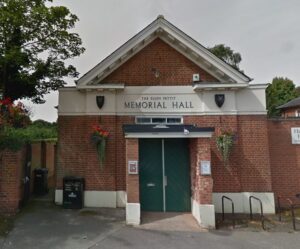
So what was the new hall used for in the first year after the opening? These are the events reported in the local press:
September 1928
- The opening social in connection with the local branch of the Church of England Temperance society was held. There was good attendance. Mr. W. Wooding was M.C. The programme included songs by Mr. Fred Walker, recitations by Miss French, violin solos by Mr. Ken Russell, and dances. Mrs. W. Wooding was pianist. The prizes in connection with the advertisement guessing competition were won by Messrs. W. C. Wynn, and Chas. Hart. Refreshments were provided by the Committee.
October
- St Michael’s Church Club held a lantern-lecture on church architecture by Mr Janes, showing various cathedrals, abbeys and churches, followed by a dance and musical games.
November
- A lantern-lecture on “Some aspects of Indian Life” was given by Rev. E. L. Johnson of Chalgrave, who had spent many years there as a missionary. A social evening followed.
- To assist the funds of St. Michael’s Church, there was a “Pound” day and sale of gifts. Competitions for best home-made cakes and other delicacies were held and the products were sold. This followed special performances of “Scenes from Cranford” and two playlets, one written by Miss Catherine Gaskoin and presented Mr. C. J. B. Gaskoin and Miss Muriel Gaskoin and friends.
- The week of entertainments from 4th-11th raised £94 19s for St. Michael’s Church, covering most of the remaining furnishing costs.
December
- The Wavendon Poor’s Bread Charity used the hall to distribute their annual allocation of 2lb loaves on St. Thomas’ Day. 240 loaves were given out by the Church wardens.
January 1929
- A New Year social event was held by St Michael’s Church Club.
February
- A variety concert, in aid of the St. Michael’s Church New Organ Fund, was given by the Martin’s Concert Party from Fenny Stratford. The programme, given under the direction of Mr. C. J. Jones, included a number of well-known songs and choruses, and several sketches.
- A lantern-lecture was given, the first in a series for lent, on “Our Favourite Hymns” by Rev. C. H. Gilsen. The Vicar presided.
March
- The fifth lantern-lecture was based on the hymn “O day of rest and gladness”, with pictures on the subject of remembrance of the Sabbath.
- The concluding lantern-lecture was on “All hail the power of Jesu’s Name”. The Bible lesson from St. John ch.19 and the connective readings were given by the Rev. C. H. Gilson, and the pictures shown depicted the heroes and heroines of the ages, concluding with the triumphant coronation the Christ King. Mr. Bert Mann was the lanternist.
April
- A jumble sale held and realized a very satisfactory sum in aid of the preliminary expenses of the garden fete in connexion with the annual sale of work.
- In connection with St. Michael’s Church Club, a social and dance was held, when, to mark the esteem in which the Rev. C. H. Gilson is held, parishioners were invited to be present at a gathering presided over by the Vicar, supported by the churchwardens. The Vicar paid tribute to the work and service of Mr. Gilson and handed to him a cheque for £21 7s 9d subscribed by the parishioners. He also handed him a portfolio clock with luminous dial, inscribed, and enclosed in pigskin case, from the members and Committee of St. Michael’s Church Club of which he has been Hon. secretary since its inception.
June
- Tile monthly meeting of the Mothers’ Union was held. Mrs. Blackmore, Deanery President, conducted the meeting and after a brief service, Mrs. Blackmore gave an inspiring address upon the Ten Commandments.
July
- A meeting of women was held, addressed by Bishop Lander and the Rev. C. T. Wilkinson, of the Christian Missionary Society. There was a large attendance which included many from other parishes in the Deanery. Afterwards a tea was held, to which a large number sat down.
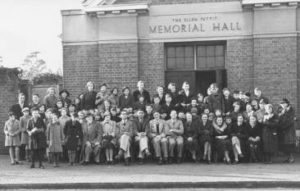
But what of Alfred Pettit himself? He resigned from his directorship at the Leighton Buzzard New Corn Exchange Company in April 1930, citing difficulty in attending their meetings. That is the last mention of him in the local press until he died in 1934. From the Bedfordshire Times 16th February:
“MR. ALFRED W. PETTIT – DEATH OF WOBURN SANDS PUBLIC WORKER
The death of Mr. Alfred William Pettit, of “Croyland”, Aspley Heath, which was reported in last week’s Bedfordshire Times and Woburn and District Reporter, removes a well-known resident whose business was in London. Mr. Pettit died on 7th February at his home, after a long illness, aged seventy-eight. He was the eldest son of the late Mr. and Mrs. William Pettit, Sherington, and a brother, Mr. Richard Pettit, is a farmer near Newport Pagnell.
Mr. Pettit became a draper after an education at Eaton Socon. He entered the establishment of Messrs. Harvey and Nichols, of Knightsbridge. Later he founded a business in Kensington High Street, and upon acquiring the leasehold had the premises rebuilt on modern lines. He was a shrewd business man, and under his guidance the establishment became as well-known as any of its kind in London. The business is still known as Pettit’s, although Mr. Pettit retired from active participation in it many years ago.
Mr. Pettit was, until failing health prevented, very active in all local affairs. He was a church warden at St. Michael’s Church and he and his wife, who died about six years ago, served the church well. To his wife’s memory, he created in 1928 the Ellen Pettit Memorial Hall.
Mr. Pettit was a fine horseman, and hunted with the Oakley. He was Chairman of the Board of Directors of the Aspley Guise and Woburn Sands golf course, which he helped bring into being and to develop. He was a member the Woburn Sands Bowling Club. All organizations which had as their object the social welfare of the district claimed his interest and help, and he was greatly respected. At one time he represented Aspley Heath on the Ampthill Rural District Council, and was a member of the Food Committee at Ampthill during the war.
THE FUNERAL
The funeral took place on Saturday at St. Michael’s Church, and was conducted by Bishop Lander and Canon Scott, Rector of Salford. The service was choral, the hymn “Abide with Me” being sung and Psalm 23 chanted. Mr. H. Seabrook and Mr. A. Hill, L.R.A.M. were the organists and a full choir was present. Canon Scott gave a short address in appreciation of Mr. Pettit’s church work. A large number of people attended, representing the various organizations with which Mr. Pettit was connected. Among local people there were Mr. E. F. Bathurst and Mr. W. A. Foll (representing the Aspley Guise and Woburn Sands Golf Club). P.c. Emmerton and Messrs. J. Coleman. C. Litchfield, Chapman, G. Lawson, and C. Garrett (special constables, who accompanied the cortege from “Croyland” to the church), Messrs. H. W. Bazley and C. L. Denton (Churchwardens), the Rev. F. Eley, Mr. H. C. H. Sanders, Mr. and Mrs. Stanbridge, Mr. J. McMurtrie, Mr. F. C. Atkinson, Mr. W. H. Page, Mr. J. Barker, Mrs. Denton, Mrs. W. H. Bottoms, Inspector Callaway, Mr. J. Wakefield, Mr. and Mrs. Foolkes, Mr. Payne, Mr. J. Field, Mr. Collins, and Mrs. G. Hunt. The grave was lined with evergreens and flowers and the large number of floral tributes included a wreath from the Golf Club. The funeral arrangements were carried out by Mr. E. G. Smith. Hardwick Road, Woburn Sands.”
In April, his executors arrange a sale of the contents of “Croyland”. The advert for the sale listed:
“…the contents of six bedrooms, bedroom suites, antique oak coffer, fireproof safe, antique grandfather clock. Turkey carpet, mahogany dining table, pedestal writing desk, easy chairs, settee, dining-room suite, mahogany pedestal sideboard, antique marquetry bureau, chiming bracket clock, electric fires. Pianola piano (by Stock) and records, mirrors, Ethophone V 2-valve wireless set, mahogany china cabinet, antique wheel barometer. Silver & plate including silver tea set, silver cruet 1765, pair of Georgian silver salts, pair of Sheffield wine coolers, electro plated tea tray, entree dishes, cake baskets and spoons, household linen, six works on Foxhunting, old Spode tea set, china, glass, wine, kitchen utensils. A 13.9 h.p. 1926 Standard Saloon Car, 4-seater, in good order; gentleman’s riding saddle, garden tools, sundial, 11 pullets, boarded and iron garage (18ft. by 12ft.), plants in pots, and numerous outside effects.”
Alfred left nearly £25,000 in his will. There were bequests of £1000 to Ethel Mary Johnson (“whether or not still in his service”) and £25 each to Minnie Wait and his gardener Charles Riddy (“if still working for him”). St. Michael’s was given £50 on condition that he and his wife’s graves were kept in good order. If not, it was to go to the Bedford County Hospital.
During World War Two, it was used as a WVS Canteen for the c. 300 members of 339 Co. Pioneer Corps., who were billeted here to oversee the ammunition stores on Wavendon Heath.
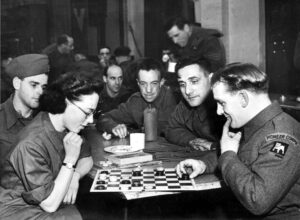
The St. Albans Diocese sold the Ellen Pettit Memorial Hall to Newport District Council on 5th January 1970. The NPRDC then let the hall to Woburn Sands Parish Council, until the Parish Council could secure funding through a Public Works Loan. This was achieved on 1st September 1970. The Parish Council then extended the building at the side, (the toilet, kitchen, and small room) which was completed in 1971 and it was opened to the public for the benefit of all Woburn Sands residents.
When Alfred had retired from his London shop, it was taken over by his assistant Thomas Hiscock. That family ran it for three generations before it went into liquidation in 1977. Some of the oldest employees (one had worked there since 1917!) could still remember Alfred Pettit and how he would ride in his carriage up and down Kensington High Street with a Dalmatian dog following behind. He would still pop in to see how things were going well after he had left. They had a large mail-order department, with sales all over the world.
The hall has been the scene of countless social events, plays, concerts, elections and parties since. Woburn Sands Town Council still operate it and are based in the offices at the rear. It continues to be a centre for community events, almost a hundred years after Alfred William Pettit’s generous gift in the name of his much-loved late wife.
Page last updated August 2020.
